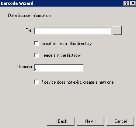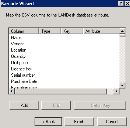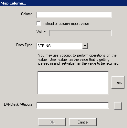Barcode CSV import wizard
You can use this wizard to create a rule that automatically copies a .CSV file from a barcode scanner or other source, drops it into a specified directory, and then imports the data into the inventory database.
Barcode CSV import rules are essentially the same as import data rules. The main difference is that a service is monitoring the directory specified in the rule. If a .CSV file is dropped into that directory, the service will process the file by importing the data into inventory and removing it from the directory.
Open the wizard by right-clicking Barcode CSV Import in the DTS tree and selecting New rule. Enter a unique name and description for this rule, then select the database where the rule will store the data it gathers. On the continuing wizard pages, enter the following information:
File: The full path of the .CSV file to import. If you're importing all files in a directory, enter the name of just one file that can be used to show columns.
Import all files in this directory: Processes all .CSV files in this directory. All files must have the same format and columns for this option to work correctly.
Headers in the first row: If column headers (names) are in the first row, select this check box.
Delimiter: The column delimiter used in the .CSV file, such as a comma or tab. By default, the delimiter is a comma.
If device does not exist, create a new one: If a device record doesn't already exist for the imported data, a new one will be created.
This page shows the mappings between columns in the .CSV file(s) and database attributes. Click the Edit button to create the mappings. The following columns are shown in this list:
Column: A column in the .CSV file.
Type: The attribute data type, such as STRING, DATE, and so on.
Key: The key attribute used to determine uniqueness. At least one attribute must be set as the key. Click the Set as key button to give an attribute this status.
Attribute: The database attribute that's mapped to a column in the .CSV file.
Click the Finish button. Your new rule will appear in the Barcode CSV Import > All Rules folder.
From this page, you can create the mappings between columns in the .CSV file and the database attributes.
Column: The name of the column in the .CSV file to map to.
- Instead of column import value: You can import a number of columns in the file, but then set one attribute to a constant value. By selecting this option, you can enter a static value and ignore the column in the file.
Data type: The data type of the file column (STRING, DATE, and so on).
VBScript: You can use VBScript to modify the incoming data (optional). Click the Test button to verify that the VBScript works.
Ivanti attribute: The attribute in the inventory database to map to.


